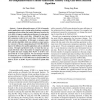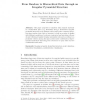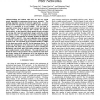IPL
2002
13 years 4 months ago
2002
Splay trees are self-organizing binary search trees that were introduced by Sleator and Tarjan [12]. In this paper we present a randomized variant of these trees. The new algorith...
ASPDAC
2008
ACM
13 years 6 months ago
2008
ACM
Content addressable memory (CAM) is frequently used in applications, such as lookup tables, databases, associative computing, and networking, that require high-speed searches due t...
GBRPR
2009
Springer
13 years 9 months ago
2009
Springer
This paper proposes to transform data scanned randomly in a well-defined space (e.g, Euclidean) along a hierarchical irregular pyramidal structure in an attempt reduce search time...
GLOBECOM
2006
IEEE
13 years 10 months ago
2006
IEEE
Flooding and random walk (RW) are the two typical search algorithms in unstructured peer-to-peer networks. The flooding algorithm searches the network aggressively. It covers the m...
BIBE
2007
IEEE
13 years 11 months ago
2007
IEEE
—The performance of maximum likelihood searches can be boosted by using the most parsimonious tree as a starting point for the search. The time spent in performing the parsimony ...



